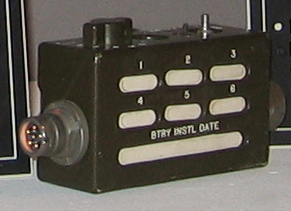KYK-13

KYK-13 on display at the National Cryptologic Museum.
The KYK-13 Electronic Transfer Device is a common fill device designed by the United States National Security Agency for the transfer and loading of cryptographic keys with their corresponding check word. The KYK-13 is battery powered and uses the DS-102 protocol for key transfer. Its National Stock Number is 5810-01-026-9618.p
Even though the KYK-13 is several decades old and was supposed to have been obsoleted by the AN/CYZ-10 Data Transfer Device, it is still widely used because of its simplicity and reliability.[1] A simpler device than the CYZ-10, the KIK-30 "Really Simple Key loader" (RASKL) is now planned to replace the KYK-13s, with up to $200 million budgeted to procure them in quantity.[2][3]
Components

KYK-13
- P1 and J1 Connectors - Electrically the same connection. Used to connect to a fill cable, COMSEC device, KOI-18, KYX-15, another KYK-13, or AN/CYZ-10.
- Battery Compartment - Holds battery which powers KYK-13.
- Mode Switch - Three position rotary switch used to select operation modes.
- "Z" - Used to zeroize selected keys.
- ON - Used to fill and transfer keys.
- OFF CHECK - Used to conduct parity checks.
- Parity Lamp - Blinks when parity is checked or fill is transferred.
- Initiate Push button - Push this button when loading or zeroizing the KYK-13.
- Address Select Switch - Seven position rotary switch.
- "Z" ALL - Zeroizes all 6 storage registers when mode switch is set to "Z".
- 1 THROUGH 6 - Six storage registers for storing keys in KYK-13.
References
^ "KYK-13"..mw-parser-output cite.citation{font-style:inherit}.mw-parser-output q{quotes:"""""""'""'"}.mw-parser-output code.cs1-code{color:inherit;background:inherit;border:inherit;padding:inherit}.mw-parser-output .cs1-lock-free a{background:url("//upload.wikimedia.org/wikipedia/commons/thumb/6/65/Lock-green.svg/9px-Lock-green.svg.png")no-repeat;background-position:right .1em center}.mw-parser-output .cs1-lock-limited a,.mw-parser-output .cs1-lock-registration a{background:url("//upload.wikimedia.org/wikipedia/commons/thumb/d/d6/Lock-gray-alt-2.svg/9px-Lock-gray-alt-2.svg.png")no-repeat;background-position:right .1em center}.mw-parser-output .cs1-lock-subscription a{background:url("//upload.wikimedia.org/wikipedia/commons/thumb/a/aa/Lock-red-alt-2.svg/9px-Lock-red-alt-2.svg.png")no-repeat;background-position:right .1em center}.mw-parser-output .cs1-subscription,.mw-parser-output .cs1-registration{color:#555}.mw-parser-output .cs1-subscription span,.mw-parser-output .cs1-registration span{border-bottom:1px dotted;cursor:help}.mw-parser-output .cs1-hidden-error{display:none;font-size:100%}.mw-parser-output .cs1-visible-error{font-size:100%}.mw-parser-output .cs1-subscription,.mw-parser-output .cs1-registration,.mw-parser-output .cs1-format{font-size:95%}.mw-parser-output .cs1-kern-left,.mw-parser-output .cs1-kern-wl-left{padding-left:0.2em}.mw-parser-output .cs1-kern-right,.mw-parser-output .cs1-kern-wl-right{padding-right:0.2em}
^ KIK-30 The First Modernized KYK-13 Replacement
^ http://defensesystems.com/articles/2009/11/12/dod-cryptographic-key.aspx